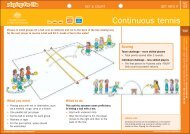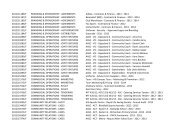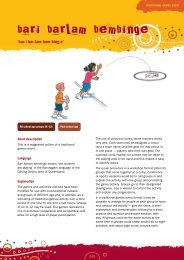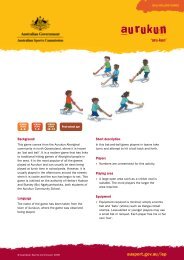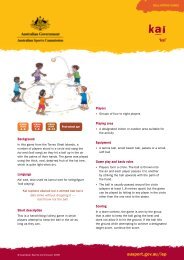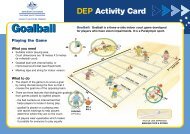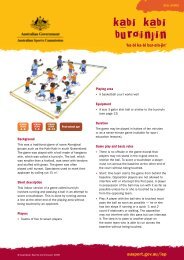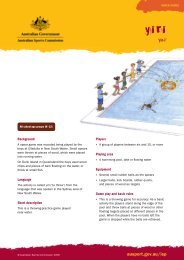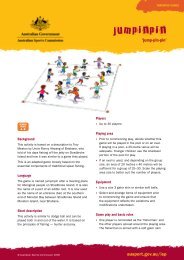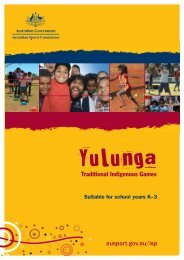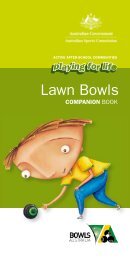the sydney 2000 olympic and paralympic games - Australian Sports ...
the sydney 2000 olympic and paralympic games - Australian Sports ...
the sydney 2000 olympic and paralympic games - Australian Sports ...
You also want an ePaper? Increase the reach of your titles
YUMPU automatically turns print PDFs into web optimized ePapers that Google loves.
PART FOUR : NSW GOVERNMENT AGENCIES GAMES SUPPORT SERVICES<br />
The Athletes Village had all <strong>the</strong> requirements of a fully serviced town. At <strong>the</strong> time of <strong>the</strong> Games, <strong>the</strong> Village<br />
was <strong>the</strong> fifth largest town in NSW. About 520 paid staff, 2,100 volunteers <strong>and</strong> 6,500 contractor staff worked<br />
in <strong>the</strong> Village. During <strong>the</strong> 33 days of operation, <strong>the</strong> beds were made 396,000 times <strong>and</strong> <strong>the</strong> 4,000<br />
bathrooms cleaned daily.<br />
Media Village<br />
The Media Village was developed from late colonial period public buildings that were once <strong>the</strong> Lidcombe<br />
hospital. The Village provided accommodation, food <strong>and</strong> beverage, work environment <strong>and</strong> 24 hour<br />
services expected from a modern hotel as well as transport to IBC, MPC <strong>and</strong> competition venues.<br />
During <strong>the</strong> Games 5,800 members of <strong>the</strong> accredited media lived in <strong>the</strong> Media Village.<br />
Technical Officials Village<br />
The 1,300 judges, referees <strong>and</strong> technical officials were accommodated <strong>and</strong> provided with hotel-type<br />
services including transport at three different university campuses within Sydney.<br />
Ticketing Operations<br />
To achieve Sydney's ticketing revenue outcome required <strong>the</strong> planning <strong>and</strong> implementation of <strong>the</strong> biggest<br />
ticket operation in <strong>Australian</strong> history. This included development <strong>and</strong> operation of order processing <strong>and</strong><br />
inventory management systems; determination of ticket prices; design, production <strong>and</strong> distribution of public<br />
offer ‘Ticket Book’; seat allocation; printing <strong>and</strong> distribution of tickets; <strong>and</strong> promotion, marketing <strong>and</strong> sales<br />
through box offices, call centre <strong>and</strong> internet.<br />
Total operations <strong>and</strong> marketing expenditure was $112.4 million.<br />
Communications <strong>and</strong> Press Operations<br />
Total gross expenditure for <strong>the</strong>se SOCOG functions was $25.2 million.<br />
Communications <strong>and</strong> Community Relations<br />
This involved management of SOCOG’s communications with <strong>the</strong> national <strong>and</strong> international media,<br />
corporate business, community <strong>and</strong> sporting groups, tourism bodies, councils, schools, ethnic <strong>and</strong><br />
indigenous communities, <strong>and</strong> <strong>the</strong> general public. In <strong>the</strong> years leading up to <strong>the</strong> Games <strong>the</strong> focus was to<br />
inform <strong>and</strong> inspire <strong>Australian</strong>s to embrace Olympism <strong>and</strong> build support for <strong>the</strong> Games. This was<br />
particularly important for campaigns such as Volunteer Recruitment <strong>and</strong> ticket marketing, <strong>and</strong> launch of <strong>the</strong><br />
mascots <strong>and</strong> <strong>the</strong> Torch Relay.<br />
O<strong>the</strong>r key communications elements included <strong>the</strong> National Education Program which reached over three<br />
million <strong>Australian</strong> students to ensure all <strong>Australian</strong> students experienced a sense of involvement in <strong>the</strong><br />
Sydney Games through curriculum-focused initiatives.<br />
SOCOG’s communications activities were merged into a Sydney <strong>2000</strong> operation from <strong>the</strong> beginning of <strong>the</strong><br />
year <strong>2000</strong> to ensure <strong>the</strong>re was a co-ordinated public communications strategy <strong>and</strong> release of information<br />
(e.g. ‘Spectator Guides’) during <strong>the</strong> critical months leading up to <strong>the</strong> Games <strong>and</strong> over <strong>the</strong> Games period.<br />
Press Operations<br />
This Program had responsibility for providing all facilities <strong>and</strong> services, including publications, Games<br />
results <strong>and</strong> o<strong>the</strong>r information for <strong>the</strong> members of <strong>the</strong> written <strong>and</strong> photographic press at <strong>the</strong> Media Press<br />
Centre (MPC) <strong>and</strong> all Games competition venues.<br />
82



